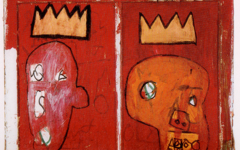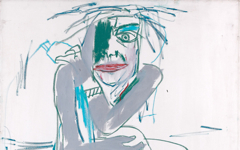Basquiat’s Boone (1983)
Many will think that Jean-Michel Basquiat's portrait of his art dealer, Mary Boone, is a joke, a send-up in line with how Marcel Duchamp famously placed a moustache on the Mona Lisa. It cannot, of course, resemble Boone which is why Basquiat painted her name on it. However, if you know that the Mona Lisa is a metamorphosis of Leonardo’s own features - and the feminine muse in Leonardo's mind - the Mona Lisa's presence should give pause.
Few know, as artists do, that just as Leonardo turned his features into the Mona Lisa, other painters turned the Mona Lisa's features into their portraits, thereby linking their own identity with Leonardo's. That is why the Mona Lisa is so important to art. You may not see her but she is everywhere.1 That is also why....
Click next thumbnail to continue
...Basquiat created a clever monogram. He formed a B, the first letter of Boone's name, by painting a red L and then a black one on top. Only after emphasizing the L did he add the sideways arches to complete the B, thereby leaving a hint that what resembles a B is really B and L combined, for Basquiat and Leonardo..
But where is the portrait of Boone?
Click next thumbnail to continue
Surprisingly, Basquiat's portrait of Boone is, despite our expectations, not unlike her. Her polished red lips and black hair parted down the middle were such dominant features of her celebrated "look" in the 80's that, when presented next to the Mona Lisa with red lips, there is some resemblance. This would be particularly noticeable to artists who are used to recognizing one or two features as a substitute for the whole. It is a demonstration in reverse of how great masters create portraits and is therefore, in its own way, a little masterpiece.
Click next thumbnail to continue
The actual portrait, though, would not fit art's traditions unless it represented Basquiat himself. It does that too. Those big red lips painted crudely are a clear reference to how white actors used to use blackface to impersonate black men. Thus Mary Boone becomes a feminine alter ego of Basquiat, a symbol of his androgynous mind. Underneath all, though, is Leonardo.
See conclusion below
There is one more sign of Basquiat's poetry and his presence. The Mona Lisa's left eye is blacked out to indicate an artist's dual perception: one eye open to exterior reality, the other closed for insight. It is such a common but little-seen feature in art, as we show in entries in "Insight-Outsight", that Basquiat must have added it to further represent himself in Boone. In Basquiat's complex and clever construction, a un-naturalistic depiction of his own mind, he himself is a veiled reincarnation of Leonardo while Mary Boone, his imagined muse and alter ego, becomes a contemporary reincarnation of the Mona Lisa. Thus, this portrait painted by a rebellious 24-year old says in Leonardo's own pictorial language, a language still mostly unknown: "I am the Leonardo of the twentieth century." Believe it or not.
More Works by Basquiat
Notes:
1. Salvador Dali, for example, placed his own peculiar mustache on the Mona Lisa's face for the same reason. He knew that she was a metamorphosis of Leonardo's own features, as first explained by Lillian Schwartz. See Schwartz, “The Art Historian’s Computer”, Scientific American 272, April 1995, pp. 106-11
Original Publication Date on EPPH: 01 Nov 2010. | Updated: 0. © Simon Abrahams. Articles on this site are the copyright of Simon Abrahams. To use copyrighted material in print or other media for purposes beyond 'fair use', you must obtain permission from the copyright owner. Websites may link to this page without permission (please do) but may not reproduce the material on their own site without crediting Simon Abrahams and EPPH.







